The 1918 Influenza Pandemic: The Deadliest Outbreak in Modern History & Its Lasting Impact
📌 Discover the devastating Influenza Pandemic of 1918-1919, which killed up to 100 million people worldwide. Explore rare historical documents, Red Cross relief efforts, public health measures, medical experiments, and the debate over flu masks and vaccines. A must-read for historians, educators, genealogists, and researchers studying pandemic history.
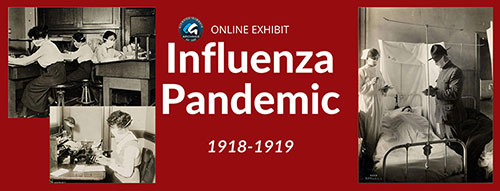
📜 The Influenza Pandemic of 1918-1919—A Global Catastrophe & Medical Mystery
🔍 The Deadliest Pandemic in Modern History
The Influenza Pandemic of 1918-1919, commonly known as the Spanish Flu, was one of the deadliest health crises in human history, killing between 50 to 100 million people worldwide—far surpassing the total casualties of World War I. This pandemic ravaged civilian populations and military personnel alike, with U.S. deaths estimated between 500,000 and 675,000.
This page provides an invaluable archive of historical documents, photographs, reports, and scientific studies that bring to life the harrowing experiences of those who lived through this pandemic. It is particularly valuable for:
✔ Historians examining the global impact of pandemics
✔ Educators teaching public health history
✔ Genealogists tracing ancestors who lived during the 1918 flu
✔ Medical researchers studying early pandemic responses
On November 2, 1918, the United States Public Health Service reported that 115,000 persons had died from influenza and pneumonia. The battle deaths of the American Expeditionary Forces were 48,900, less than half the influenza deaths, and the pandemic was not yet under control.
The contagion continued to spread and Red Cross relief was carried on until late in the spring of 1919. In round figures, the number of civilian deaths from influenza and pneumonia totaled 150,000 persons. As for the US Government, a concerted effort was made to suppress news regarding the pandemic.
On 4 March 1918, one of the first cases of an influenza pandemic that would go on to be known as the Spanish flu was reported at an army camp in Kansas. The 1918 pandemic killed between 50-100 million people worldwide, and yet its origins remain unclear.
The term "Spanish" flu was coined because Spain was the only European country where the press were printing reports of the outbreak, which killed thousands in the armies fighting World War I (1914–1918). Other countries suppressed the news in order to protect morale. In the U.S., about 28% of the population of 105 million became infected, and 500,000 to 675,000 died. This richly illustrated section is ideal for researchers, students, and genealogists.
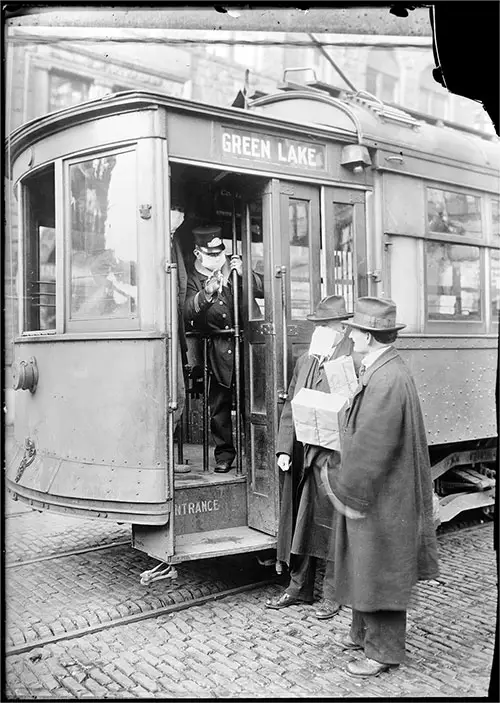
Influenza Pandemic of 1918-1919 Image Library
Books, Brochures, Articles, and Other Ephemera Provided Photographs and Illustrations of the Conditions and Experiences of Americans During the Influenza Pandemic of 1918-1919.
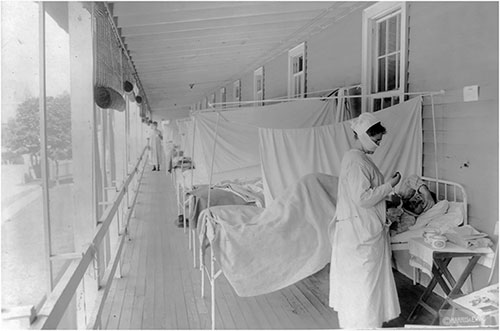
Spanish Influenza Bulletin - 1918
If the prevalence of influenza increases to any degree, it will he manifestly impossible to provide hospital care for any considerable proportion of the cases, and the general hospitals will have to be depended upon to assist. The restrictions upon isolation of patients in hospitals should, therefore, not be severe.
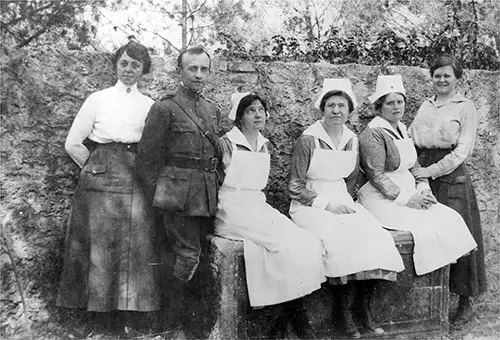
Possible Origins of the Spanish Influenza - 1918
This disease Spread over a considerable part of Europe and about three months ago made its appearance among passengers on Transatlantic steamers arriving in New York
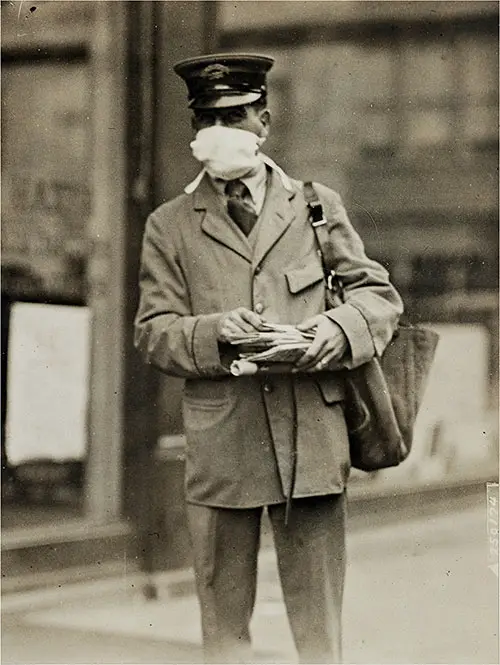
"Spanish Influenza"—"Three-Day Fever"—"The Flu." - 1918
Circular authored by Rupert Blue, Surgeon-General of the United States Public Health Service, was published in 1918 regarding influenza. The interesting and instructive bulletin covered typical questions about the influenza pandemic, origin, outcome, prognosis, and treatment.
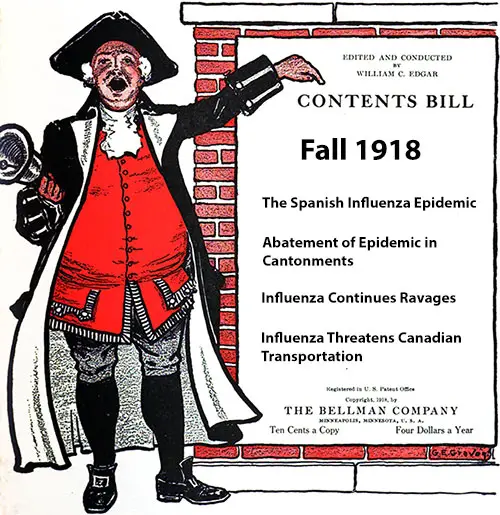
The Growing Influenza Pandemic Reported by The Bellman - 1918
Before television and radio, the newspapers and magazines were tasked with spreading important news of the day. This is a series of news briefs on the Influenza Pandemic of 1918, as reported by a weekly news magazine called The Bellman of Minneapolis, Minnesota.
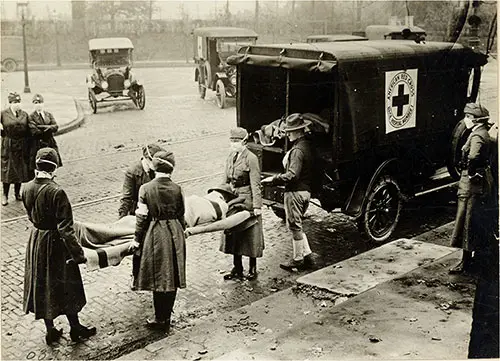
Pneumonia and Influenza - 1918
As "Spanish Influenza" is not uncommonly complicated by pneumonia it might be well to give a brief description of a few of its characteristic manifestations. It usually begins suddenly, with the usual symptoms of "catching cold," such as sneezing, running of the nose and eyes—harsh dry cough—pains in the back, back of neck, legs or headache.
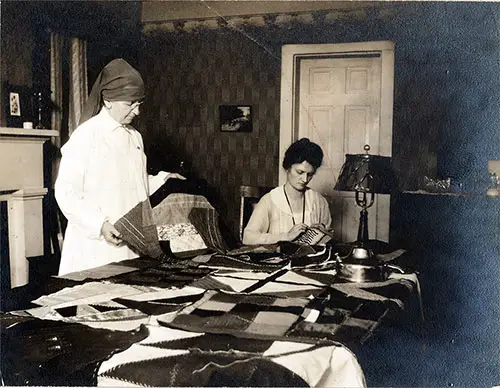
The Mysterious Influenza - 1918
A curious thing about outbreaks of influenza is the tendency to look upon each appearance as a new disease and bestow upon it a new name. That was done with the first "grippe" epidemic of many years since, and it has been repeated in the present instance.
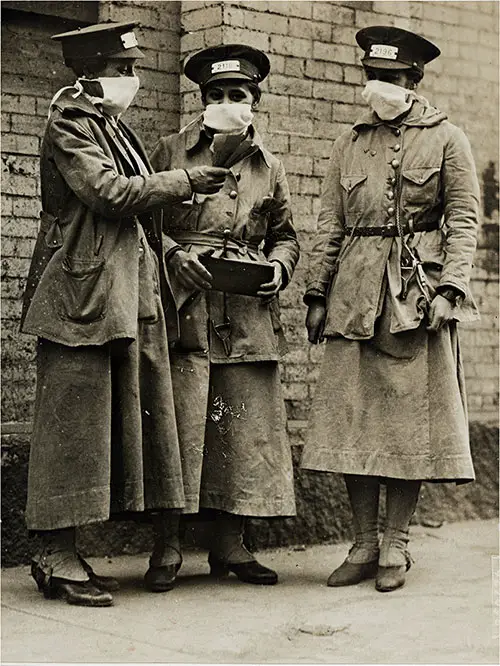
The laxity of port authorities on our Eastern coast is responsible for an invasion that has caused more deaths among peaceful citizens than the deadly weapons of the enemy have effected on the front of battle.
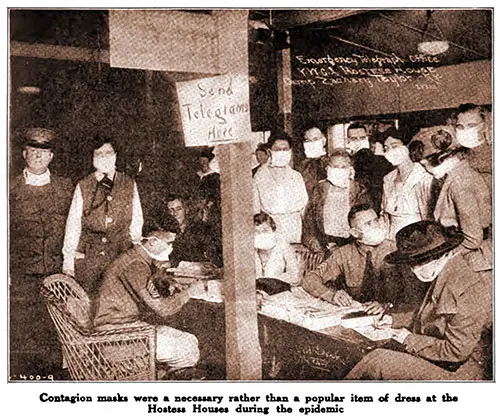
The Hostess House and the Influenza Epidemic - 1918
So great was the demand for masks at hospitals around Camp Lewis, Washington, where influenza cases have been numerous, that everyone who could wield a needle and thread was pressed into service.
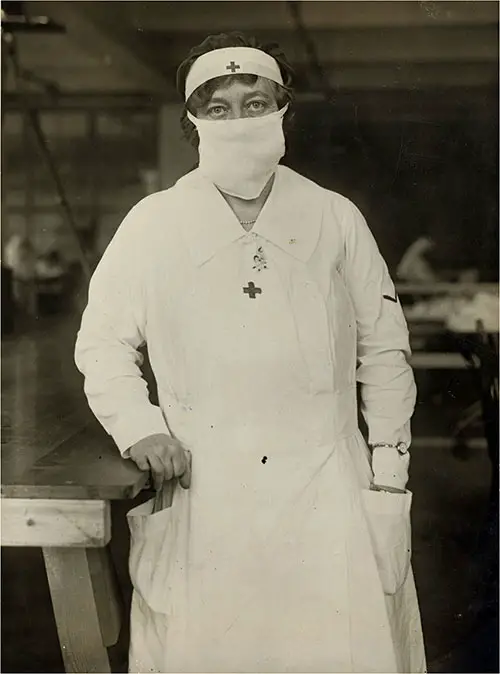
How the "Flu" Mask Traps the Germ - 1918
Nevertheless, public opinion is right, and a part, at least, of scientific opinion is wrong, for the influenza mask really does protect, and certain experts offer explanations as to how it does it.
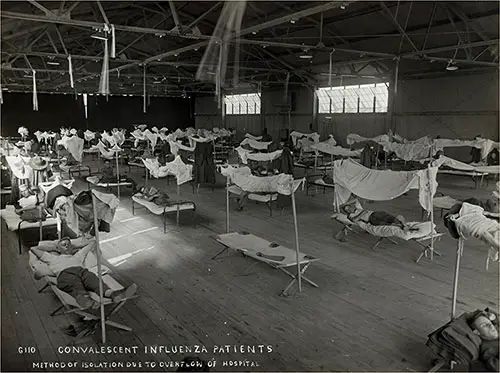
Is the Influenza a Chinese Plague? - 1918
Acts Tending to Identify the recent epidemic of influenza with a form of pneumonic plague that has raged in parts of China for several years past are adduced in The Medical Record by Capt. James Joseph King, of the United States Army Medical Corps.
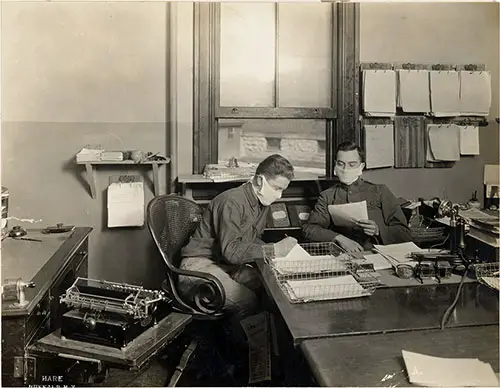
Expert Medical Advice on Influenza - 1918
If those who feel ill would stay at home, if those who are well would avoid traveling in railway-carriages with the windows closed, or in unventilated trams and busses; and, above all, if the public would forego picture-palaces or other crowded places of amusement so long as the epidemic continues, much would be done to limit the spread in populous centers.
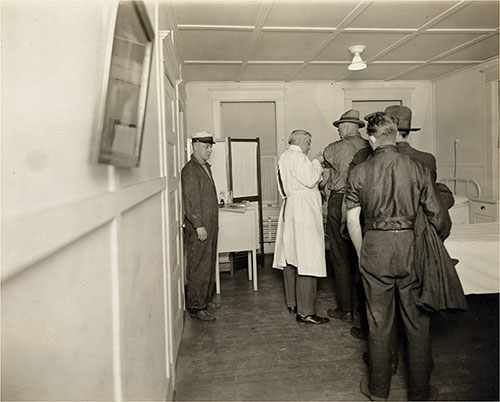
Vaccination Against Influenza - 1918
According to this journal, we have no record of any properly conducted and controlled experiments on human beings with influenza vaccines. No results of careful observations are as yet at hand.
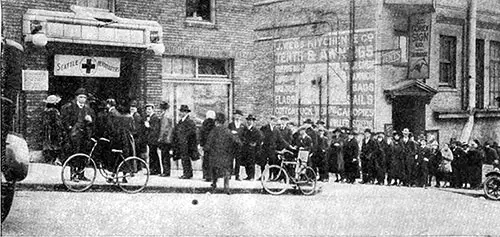
Battling with the "Flu" - 1919
Within the space of one day the Red Cross all over the country was organized in readiness for emergency needs. At the same time the division managers were in structed to reprint and distribute a pamphlet on the prevention and cure of influenza which had been prepared by Surgeon-General Blue.
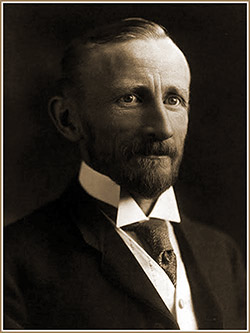
Some Statistics of Influenza - 1919
There is no satisfactory definition of influenza, and experience has shown that the complications resulting from that place are more fatal in their consequences than the disease itself as a primary cause of death.
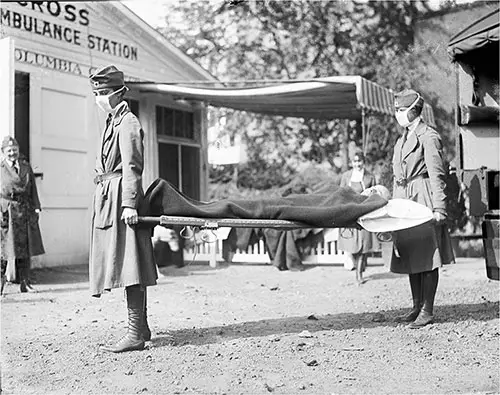
For want of a more accurate name this modern plague, the like of which has not been experienced by humanity in four hundred years, has commonly been called Spanish influenza.
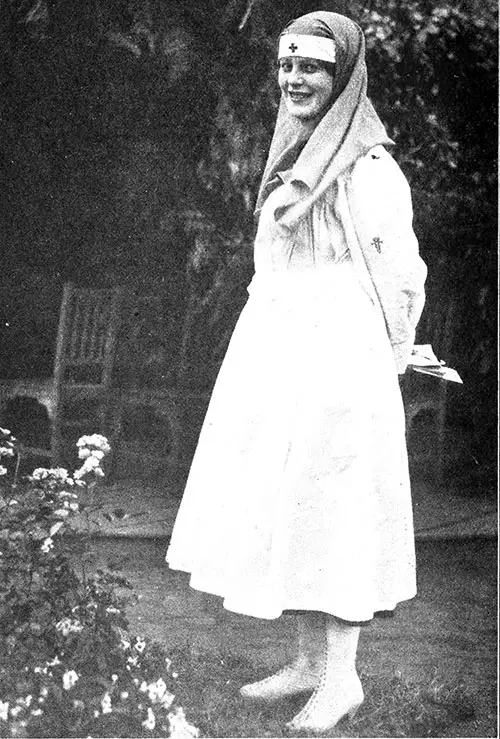
Spanish influenza Pandemic - 1919
Spanish influenza is not a thing of the past. Judging from the history of such epidemics, this latest and most violent of plagues may be expected to return frequently for several years.
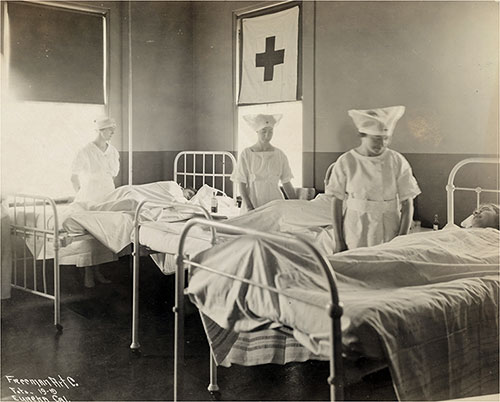
The Influenza Mystery Deepens - 1919
It may be recalled that medical scientists are by no means agreed as to the nature of influenza. The influenza bacillus discovered by Pfeifier in 1892 has, it is true, been found associated in a large proportion of the cases during the present world-wide epidemic.
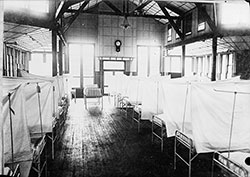
Influenza—The Sphinx of Diseases - 1919
The contributing causes of influenza include such factors as overcrowding, universality of travel, promiscuous coughing and sneezing of individuals suffering from the disease, etc. The exciting cause of influenza, i. e., the particular germ responsible for setting up the infection, is not known.
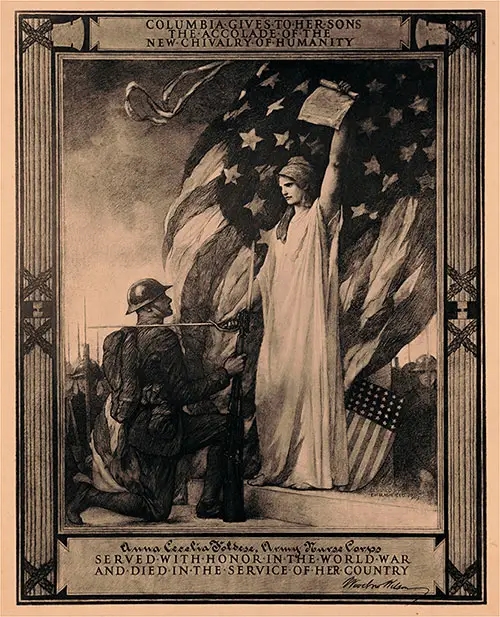
Discovery of the Influenza Germ - 1919
An account of the discovery by Major H. Graeme Gibson, Major Bowman, and Captain Connors of the Allied army medical services, of what is stated to be very probably the causative germ of influenza appeared lately in the London Times.
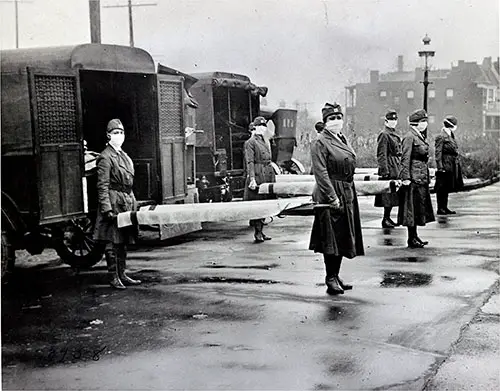
What Will You Do When the Flu Comes? - 1919
The thing to do, then, is for some organization in every community to lay plan; to meet the first appearance of the disease with the most efficient attack that medical science and business sense can devise.
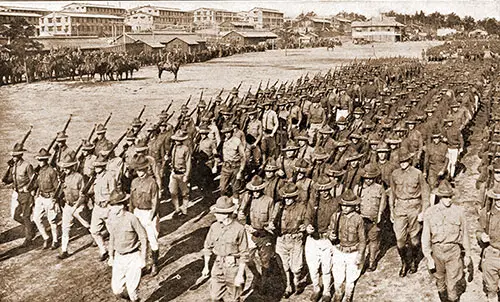
In the Grip of the "Flu" (Spanish Influenza) - 1920
In the cities and towns throughout New England the doctors were so busy that the services of a physician were hard to get, for the medical men were working day and night, with far more cases on their hands than they could find time to attend. And nurses were at a premium.

Report on The Pandemic of Influenza, 1918-19
This report, taken in conjunction with the Report on the Mortality from Influenza in England and Wales during the Epidemic of 1918-19 recently issued by the Registrar-General (Cmd. 700), constitutes the official record which it is necessary to make concerning the outbreak.
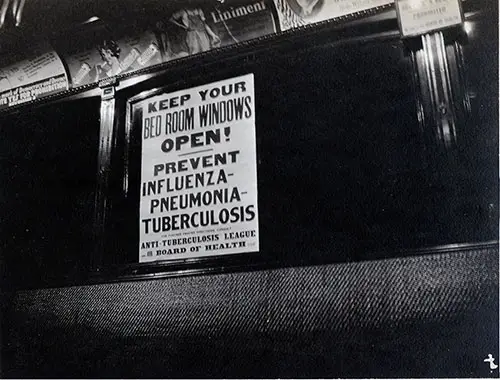
Epilogue of the 1918-1919 Influenza Epidemic - 1921
At best our knowledge of the cause and manner of spread of influenza is fragmentary and insufficient. Attempts to outline a system of control and prevention based upon present concepts are met with many discouragements.
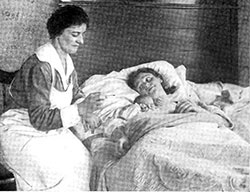
Influenza Epidemic - The Story of the Red Cross Nurses - 1922
The medical and nursing relief afforded by the Red Cross to the civilian population in large cities, industrial centers, small towns, and rural and isolated communities was probably as extensive as has ever been offered by any Red Cross society in any country and is therefore of interest.
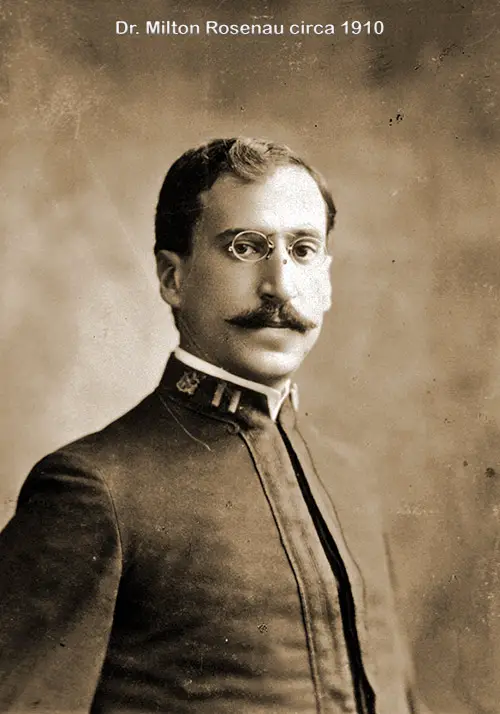
The Rosenau Experiment: The 1918 Influenza Pandemic & The Failed Quest to Prove How It Spread
The Rosenau Experiment (1918-1919) is one of the most fascinating and perplexing scientific investigations conducted during the Influenza Pandemic of 1918, a deadly outbreak that killed an estimated 50 million people worldwide. Led by Dr. Milton Joseph Rosenau and conducted by the U.S. Public Health Service and the U.S. Navy, this experiment aimed to determine how influenza spread and whether it could be intentionally transmitted under controlled conditions.
Surprisingly, despite direct exposure to infected patients, nasal and throat inoculations, and even injections of infected blood, not a single volunteer developed the flu. This shocking result challenged prevailing assumptions about how the virus was transmitted and left scientists baffled.
Influenza Pandemic Vaccines
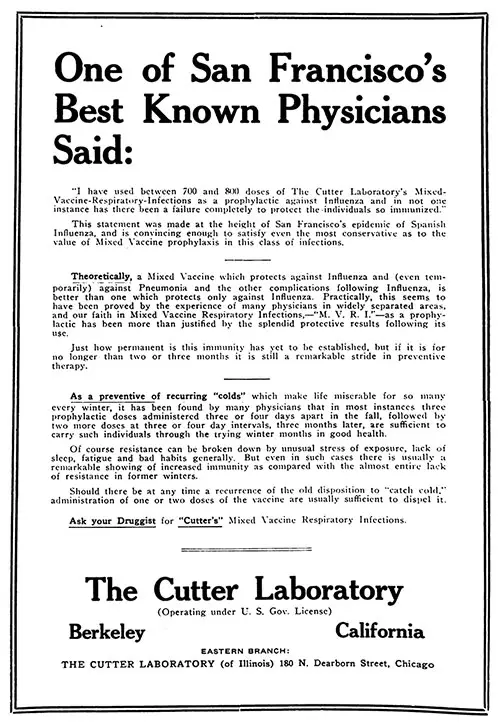
Cutter Laboratory's Mixed Vaccine for Influenza Pandemic - 1918
I have used between 700 and 800 doses of The Cutter Laboratory's Mixed-Vaccine-Respiratory-Infections as a prophylactic against Influenza and in not one instance has there been a failure completely to protect the individuals so immunized.
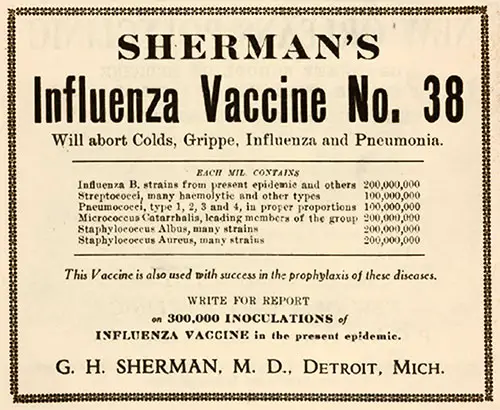
Sherman's Influenza Vaccine No. 38 - 1918
SHERMAN'S Influenza Vaccine No. 38 Will abort Colds, Grippe, Influenza and Pneumonia. This Vaccine is also used with success in the prophylaxis of these diseases. - 1918 Advertisement.
📜 Key Topics Covered in This Archive:
🦠 The origins and spread of the 1918 influenza virus
🚑 Red Cross efforts and emergency relief work
😷 The use of masks and early public health measures
🏥 The struggle of hospitals and medical professionals
💉 Early vaccine experiments and medical treatments
📜 Government censorship and media suppression of flu-related news
🌟 Most Engaging & Noteworthy Content in This Collection
📌 The Shocking Death Toll—More Deadly Than WWI
🔹 By November 2, 1918, the United States Public Health Service reported 115,000 deaths from influenza and pneumonia.
🔹 This was more than double the number of battle deaths (48,900) suffered by American soldiers in WWI.
🔹 The total U.S. civilian death toll reached 150,000, and the pandemic was not yet over.
📜 Why This Matters:
✔ Puts into perspective the pandemic’s impact compared to the war.
✔ Demonstrates how influenza overshadowed even the deadliest military conflict of its time.
✔ Highlights the challenge of tracking real-time pandemic data in the early 20th century.
📌 The Flu’s Mysterious Origins & Why It Was Called “Spanish”
🔹 The first reported case in the U.S. was at Fort Riley, Kansas, on March 4, 1918.
🔹 The flu spread rapidly through military camps and civilian populations, eventually infecting over 500 million people globally.
🔹 It was wrongly called the "Spanish Flu" because Spain was the only country reporting it freely—other nations censored flu-related news to avoid damaging wartime morale.
📜 Why This Matters:
✔ Challenges the assumption that the flu originated in Spain.
✔ Shows how wartime censorship contributed to misinformation.
✔ Provides a historical parallel to how pandemics are named and misattributed today.
📌 The Red Cross & Emergency Relief—A Nation in Crisis
🔹 Hospitals were overwhelmed, and emergency tents and makeshift infirmaries were set up in many cities.
🔹 The Red Cross played a crucial role in providing nurses, transportation, and emergency aid.
🔹 Red Cross motor corps units transported the sick, while volunteer nurses risked their lives to care for the ill.
📜 Notable Images:
📷 Red Cross Motor Corps in St. Louis, Missouri (October 1918) – Shows how ambulance services were mobilized during the crisis.
📷 Volunteer Nurses in Eureka, California (1918-1919) – Highlights the role of women in pandemic response.
📜 Why This Matters:
✔ Illustrates how disaster relief organizations operated during a pandemic.
✔ Demonstrates the role of volunteerism and civilian response.
✔ Draws parallels to modern responses to pandemics like COVID-19.
📌 The Influenza Mask Debate—Protection or False Security?
🔹 Face masks were widely used in cities like Seattle and New York.
🔹 Some medical professionals questioned their effectiveness, while others credited them with reducing transmission.
🔹 A 1918 article in The Medical Record suggested influenza might be a pneumonic plague from China, fueling xenophobic fears.
📜 Notable Images:
📷 New York City Letter Carrier Wearing a Protective Mask (1918) – A rare glimpse of early PPE in use.
📷 Seattle Citizens Lining Up for Masks at Red Cross Headquarters – Shows public health efforts to distribute protective gear.
📜 Why This Matters:
✔ Illustrates how historical mask-wearing debates mirror modern controversies.
✔ Raises questions about early misunderstandings of flu transmission.
✔ Demonstrates how fear and misinformation shaped public health responses.
📌 The Rosenau Experiment—Failed Attempts to Prove How the Flu Spread
🔹 Dr. Milton Rosenau, a leading epidemiologist, conducted experiments with 100 U.S. Navy volunteers to try to deliberately infect them with influenza.
🔹 Volunteers were injected with flu bacteria, exposed to infected patients, and even had flu-stricken individuals cough in their faces.
🔹 None of them got sick, challenging the prevailing theory that flu was spread solely by direct contact.
📜 Why This Matters:
✔ Demonstrates the difficulty of understanding disease transmission in 1918.
✔ Highlights how medical science evolved and adapted.
✔ Has relevance today in how we study airborne diseases.
📌 The Unsuccessful Influenza Vaccine Experiments
🔹 Cutter Laboratory’s Mixed Vaccine & Sherman’s Influenza Vaccine No. 38 were advertised as potential flu preventatives.
🔹 There was no real scientific evidence that these vaccines worked against influenza.
🔹 Public demand for a cure led to rushed, experimental vaccines, some of which were later debunked.
📜 Why This Matters:
✔ Shows the dangers of misinformation and rushed medical solutions.
✔ Provides a historical comparison to vaccine skepticism in modern times.
✔ Highlights the early challenges of developing influenza vaccines.
📚 Relevance for Different Audiences
📌 🧑🏫 For Teachers & Students:
✔ A case study in public health history that connects to modern pandemic responses.
✔ Provides primary source materials for research projects.
✔ Demonstrates the long-term effects of pandemics on society.
📌 📖 For Historians & Public Health Researchers:
✔ Offers a comprehensive archive of pandemic-era documents.
✔ Highlights the impact of wartime censorship on disease reporting.
✔ Provides insight into early medical experiments and their limitations.
📌 🧬 For Genealogists & Family Historians:
✔ Helps trace ancestors who lived through or died in the pandemic.
✔ Provides historical context for researching family records.
✔ Offers insight into the daily struggles of communities during the flu outbreak.
🌟 Final Thoughts: A Pandemic That Changed the World
📌 The 1918 Influenza Pandemic remains one of the most important medical crises in human history.
✔ It reshaped public health policies and emergency response systems.
✔ It demonstrated the need for international cooperation in disease control.
✔ It serves as a warning and learning tool for modern pandemics, including COVID-19.
📌 This collection of documents and images is an invaluable historical resource for educators, researchers, genealogists, and anyone interested in the impact of pandemics on human history. 🦠💉📜
